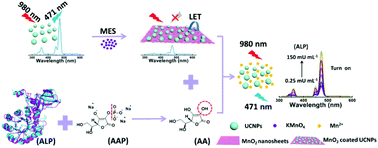A “turn-on” sensor based on MnO2 coated UCNPs for detection of alkaline phosphatase and ascorbic acid†
Abstract
Alkaline phosphatase (ALP), an extraordinary enzyme, can catalyze the dephosphorylation of small molecules, proteins and nucleic acids. ALP has been confirmed as a crucial serum diagnostic indicator, since the abnormal level of ALP is closely related to a variety of pathological processes, especially in the early diagnosis and screening of cancer. Herein, we designed a “turn-on” sensor to detect ALP and ascorbic acid (AA) based on the redox reaction between manganese dioxide (MnO2) coated upconversion nanoparticles (UCNPs) and AA. Firstly, 2 nm sized NaYF4:Yb3+,Tm3+ UCNPs were synthesized by a facile one-pot hydrothermal method. Then MnO2 coated UCNPs were prepared via electrostatic interactions between MnO2 nanosheets and UCNPs. MnO2 nanosheets could absorb blue light emitted by UCNPs near 471 nm under laser excitation at 980 nm, and so the luminescence of UCNPs was quenched based on luminescence energy transfer (LET). In the presence of AA, the luminescence was recovered again by the redox reaction between AA and MnO2 coated UCNPs. MnO2 nanosheets were reduced to Mn2+ and UCNPs were released. Furthermore, the “turn-on” sensor was applied to monitor ALP since the phosphate group of 2-phospho-L-ascorbic acid (AAP) was removed by ALP to yield AA. The bio-assay showed a good linear relationship between the restored luminescence intensities (ΔI = I − I0) and ALP concentrations ranging from 0.25 to 150 mU mL−1 with a limit of detection (LOD) of 0.045 mU mL−1 and between ΔI and AA concentrations ranging from 0.5 to 250 μM with an LOD of 0.29 μM. The luminescent sensor was also successfully applied for detection of ALP and AA in human serum samples with recoveries from 94.9% to 104.6% and 99.4% to 104.9%.



 Please wait while we load your content...
Please wait while we load your content...